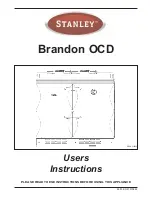
6
The ovens are indirectly heated from the outside by hot
gases from the heat source so that no flame or elements
are within the ovens. This means that full use can be made
of the whole cooking space. Both ovens are vented so that
cooking smells disappear to the outside.
VENTING FAN
This is achieved with an automatic electric fan and this will
run for 45 minutes after cooking has been completed.
MAIN OVEN
This oven is hotter towards the top than the bottom.
For best results turn food during cooking.
On low settings the oven can be used for long slow cooking
such as casseroles, stock soup, ratatouille, curries,
meringues, rice pudding etc. Turn up to a higher setting for
baking fruit cakes, victoria sandwiches, small cakes,
souffles, scones, bread and roasting etc. (See
temperature/setting chart on previous page for details).
One of the many benefits of the cast iron oven is that the
floor of the oven is hot and can be used as a cooking area
in its own right.
1.
For Baking - no need to bake pastry cases or quiche
“blind” just place the flan dish directly on the oven floor
for the whole, or part of, the cooking time to achieve
“soggy-free” pastry bases that are crisp and golden. In
the same way an apple pie can be part cooked on the
oven floor to ensure a well cooked base.
2.
For frying - when the oven is hot the floor of the oven can
be used for frying. Think of it as a hidden hot plate. A
cast iron dish is recommended. Allow it to heat up first
before adding the food. It’s an excellent method for
frying bacon and egg, fish such as trout/salmon or
onions etc. Any fat splashes are carbonised on the
inside of the oven so cleaning is minimal (carbonised
crumbs can be brushed out using a stiff brush) and
frying smells are taken away through the flue.
The top of the oven is where the grilling takes place. Do this
when the oven is turned up to a high setting. The heat
radiating from the roof of the oven seals and cooks the food
efficiently. Arrange the food on the grill rack in the meat tin
set on the highest usable shelf position.
Cast iron retains the heat so you can peep at a cake or
souffle to see how it is cooking without it sinking. For safety
reasons the oven grid shelves are non-tilt, use as directed
on the opposite page and USER INFORMATION, Page 3.
THERMODIAL
The thermodial on the Main Oven door is a guide to the
condition of the internal oven. On opening, the pointer will
appear to drop as it registers air away from the oven, do not
worry, close the door and after a few minutes it will regain
its original position.
LOWER OVEN
A valuable oven for slower more gentle cooking when the
Main Oven is turned up high, as it is roughly half the
temperature of the Main Oven. Ideal for meringues,
casseroles, milk puddings, egg custards etc. When cooking
a casserole in this oven allow it to heat through and simmer
for 5-10 minutes on the hotplate or main oven floor before
transferring to the Lower Oven. Although there are runners
on the sides of the oven for the grid shelf/meat tin, dishes
may also be cooked on the floor of the oven.
SOLID SHELF
The solid shelf can be used as a baking sheet or as a heat
deflector to protect food from over browning/cooking. It is
ideal as a solid baking sheet as it maximises the whole oven
area. When in position the solid shelf and the space above
can still be used for cooking, while it is protecting the food
below. As a heat deflector slide it in two runners above the
food. To be effective it must be used from cold and
therefore it should be stored outside the oven.
HOTPLATE
Apart from its use for boiling and simmering, the hotplate
can be used directly, for making toast, toasted sandwiches,
drop scones, see the cook book for details. After cooking
directly on the hotplate make sure you brush off any crumbs
or this could impair the boiling performance of the kettle or
saucepans.
ACCESSORIES
Further accessories, tins, shelves, solid shelves,
saucepans, aprons and gauntlets, etc are available from
your local Stockist.
COOKING HINTS


































